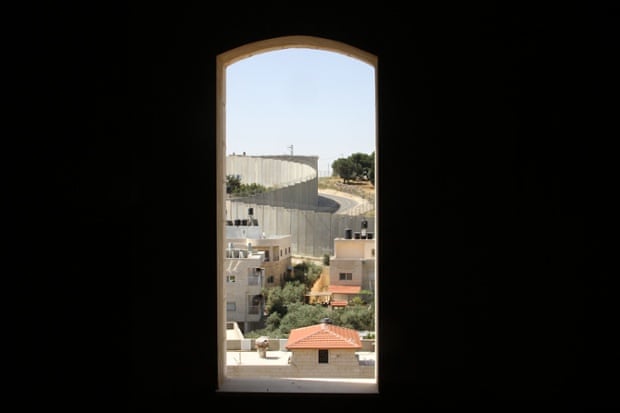Palestine's abandoned parliament – a history of cities in 50 buildings, day 46
 Sunday, May 31, 2015 at 01:04PM
Sunday, May 31, 2015 at 01:04PM Started after Israel and the PLO signed the Oslo accords 20 years ago, the empty building now embodies the dashed hopes of the failed peace process
by Ilene Prusher 29 May 2015 The Guardian

The abandoned Palestinian parliament building in Abu Dis, East Jerusalem. Photograph: Quique Kierszenbaum
Just beyond an 8-metre-high grey concrete wall – in some places decorated with graffiti and in some places burnt black by demonstrators – lies the building that was slated to become the Palestinian parliament. Today, it is a white behemoth of a building that sits hollow and unfinished, locked behind towering gates on a road that leads from Jerusalem into Abu Dis, a West Bank village just outside the Israeli-declared municipal boundaries of its capital.
A nearby guard provides the key to a building that seems to embody the dashed hopes of a failed peace process, and in particular, of a people who were told that the Oslo Peace Accords signed by Israel and the Palestinian Liberation Organisation in 1993 would lead to the creation of a Palestinian state.
Soon after, Israel began to withdraw its army from major cities in the West Bank, and the two sides agreed on a plan to divide the West Bank into three temporary territorial categories: A, B and C. Among the other creative ideas bandied about in those heady days was to base the Palestinian capital on the outskirts of Jerusalem.
The building is a hulking skeleton on the scarred landscape of the city’s outskirts, a city whose boundaries may yet be redefined and redrawn in peace negotiations. Other cities around the world have their own white elephants – large empty buildings that have failed for a variety of reasons – often due to poor planning or a financial shortfall. Sometimes, such buildings can bring down a whole neighbourhood and contribute to urban blight. But here, the story is further complicated by political realities, and stands as an architectural reminder of the dysfunction that reins in this part of the world.

The gates in front of the abandoned parliament building. Photograph: Quique Kierszenbaum
Inside, we tread over parched earth and stones, broken glass, a discarded bottle of Israeli-made Maccabi beer. One can almost imagine the political life that was envisaged here when Ahmad Qurei – widely known as Abu Alaa and one of the architects of the now-defunct peace process – invested personal and political capital in the project, and brought in his friend, prominent Palestinian-Jordanian architect Ja’afar Touqan, to design it. Qurei, now retired, describes in a film by DAAR (Decolonising Architecture Art Residency), that one of the reasons he chose this spot was that it would have a view with the Al-Aqsa mosque in the background.
“This building was a work of art,” Qurei says in the film. “We designed the eastern room with a wide window because Abu Ammar [Yasser Arafat] liked to have an image of Al-Aqsa in the background in his photos, so here his office would be located where a view of Al-Aqsa would be visible from his window. It was his dream and his dream for all of us.” Qurei explains that the location was intended to move the Palestinian leadership closer to Jerusalem.
Today, the only life to be found inside what were supposed to be Palestinian corridors of power, is a tired dog who doesn’t bother to bark at us and a desert snake curled up on top of a door frame. The main plenum hall, built in a semi-circle on levels that descend towards a speaker’s platform at the bottom of the hall, is roomy compared to the current space in the city of Ramallah – the meeting place of the Palestinian Legislative Council.


The wall, he says, not only makes it difficult for many students and faculty members to get to get to and from campus, but it makes the concept of a Palestinian capital building in Abu Dis – which lies just beyond the Israeli-declared municipal border of Jerusalem – look even less palatable than it was nearly two decades ago.
“If we have a parliament, it should be in East Jerusalem, and our political institutions should be there. Now that we took responsibility for it at Al Quds University, no one will even accept it as more than a cultural or community building.”
 APJP |
APJP |  Post a Comment |
Post a Comment |